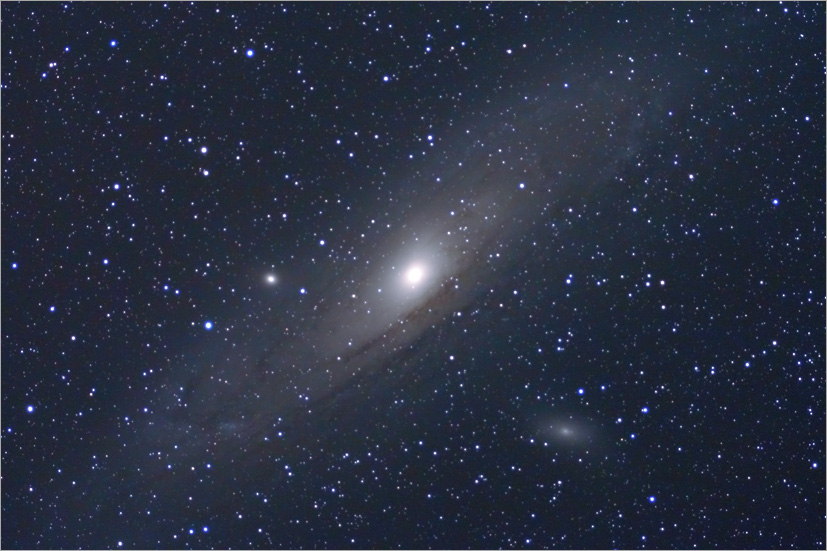
Tracked and Stacked
M31, The Andromeda Galaxy
Even though M31 is very bright for a galaxy, it is well worth the effort to shoot from darker skies.
The core of M31 is bright, but the outer arms are faint. In this image, 40 minutes of total exposure was used at a reasonably dark-sky site where the Milky Way was visible, although there was still a lot of light pollution from Philadelphia in the northwest.
If I can find a decent dark-sky site within an hour's drive of a gigantic light-polluted metropolitan area with 6 million people, you can too, no matter where you live.
|
|
M31 is the Andromeda Galaxy, a gigantic collection of more than 300 billion stars.
M31 contains stars, open clusters, globular clusters, dust and gas, nebulas of all kinds, and a gigantic black hole at its center. Companion dwarf elliptical galaxies M32 and M110 are also visible.
M31 and its companions are part of our local group of galaxies, which includes the Milky Way and Magellanic Clouds, and M33. The Andromeda Galaxy is headed towards our Milky Way Galaxy. It is expected to collide with it and possibly merge into a gigantic elliptical galaxy in about 3 billion years.
M31 is easily visible to the unaided eye from a dark site as a faint smudge of light. It is the farthest object that can easily be seen with the unaided eye, at a distance of about 2.5 million light years.
It is amazing to realize that when we look out in to space in the night sky that not only are we looking across unimaginable distances, but we are also looking back into time. M31's great distance means that it took the light, traveling at 186,282 miles (299,791 kilometers) per second, 2.5 million years to get here. So we are not seeing M31 as it looks today, but rather as it looked 2.5 million years ago.
Image Data
- Lens / Scope: Stellarvue SV70ED ED doublet refractor
- Focal Length: 336mm
- F/stop: f/4.8 with William Optics 0.8x Telecompressor / Reducer
- Exposure: Stack of sixteen 150-second exposures (40 minutes total exposure)
- Mount: Orion Sirius polar-aligned German-equatorial mount
- Guiding: None
- Camera: Unmodified Canon EOS 1000D (Digital Rebel XS)
- Mode: JPEG
- ISO: 1600
- White Balance: Custom, set on sky background
- In-Camera Noise Reduction: Off
- Filter: None
- Temp: 68F
- Start Time: 3:16 a.m.
- Date: June 28, 2009
- Location: Maxwell, NJ
- Calibration: Dark frames were subtracted from each individual light frame to remove the thermal signal.
- Processing: Standard in-camera JPEG processing. Stacked in Deepsky Stacker. Contrast and color adjusted in post processing.